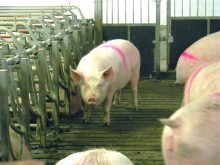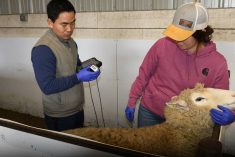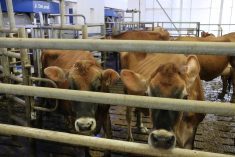Pen widths and selection weights
Pen width (ft.)
Total pen area (ft. 2)
Area/pig (ft. 2), based on 420 pigs
Min. weight at transfer (lb.)
28 2296
5.47
128
32
2624
6.25
152
36 2952
7.03
170
42
3444
8.20
203
47 3854
9.17
228
53
4346
10.35
255
Bernie Peet is president of Pork Chain Consulting Ltd. of Lacombe, Alberta, and editor of Western Hog Journal. His columns will run every second week in the Manitoba Co-operator.
Read Also

Pig transport stress costs pork sector
Popular livestock trailer designs also increase pig stress during transportation, hitting at meat quality, animal welfare and farm profit, Agriculture and Agri-Food Canada researcher says
After 36 years in the pork industry, it’s not often that I come across something that surprises me or challenges my thinking on pig production. However, visiting a new barn recently, I looked at a finishing system that seems to defy what we know about pig behaviour and how it impacts pen design.
Before describing it and explaining how it works, let’s think about how pig behaviour has influenced our approach to housing in the past. Pigs establish a social hierarchy within hours of being born – the teat order – and will fight vigorously to defend their position on the udder if necessary. Usually, at weaning, pigs are mixed into groups based on size and gender, which requires another social sort-out involving fighting to establish their ranking. Depending on group sizes and pig flow within a barn, it is possible that they may have to be mixed again during the growing and finishing stage.
Because fighting is stressful and reduces growth rate, barn design usually tries to minimize the need to mix pigs from different groups after they have been mixed at weaning. Traditionally, this meant having small, stable groups that stay together up to market weight. More recent experience with large-group systems holding 100 to 500 pigs per pen suggests pigs are more tolerant and less likely to fight than they are in groups of, say, 20 or 30. Even then, mixing is generally avoided.
Now imagine a system where pigs are deliberately mixed into new social groupings every few weeks during the finishing stage. Not only that, but one where pigs don’t fight and grow rapidly up to market weight.
Hartland Colony, located just west of Bashaw, Alberta, operates a 775-sow farrow-to-finish barn where pigs are penned in large groups from weaning to market. It regularly weans well over 400 pigs per week from 36 farrowings, occasionally up to 450. Throughout the system, gilts and barrows are penned separately.
In the nursery and pre-grower stages, or up to a weight of 41 kg (90 lbs.) group size is 200-225 and pigs are maintained in the same group that they were in from weaning onwards. However, during the finishing stage, group size is increased to 400-450 in order to make economical use of automatic sorting scales. The difference between this and other large-group finishing systems is the way in which the scales are used.
“Pigs are trained to use the scale at the pre-grower stage,” explains Martin Waldner, hog boss at the colony. “When they reach 90 lbs., the scale selects them and diverts them into the first pen in the finisher barn. As they grow, they move from pen to pen down the barn based on weight.”
There are two rows of six pens, each 82 ft. deep, of which 20 ft. is a feed court with five circular wet/dry feeders. “We kept the feed court size to a minimum to avoid pigs lying in that area once they have eaten,” says Waldner. The first pen in each row is 28 ft. wide and each successive pen is bigger to accommodate pigs as they grow, with the final pen before selection for market being 53 ft. wide. Gilts are housed in one row of pens and barrows in the other. On one day each week, the scales in each pen in the barn are set to select pigs at a predetermined weight and divert them into the next pen.
“We typically find that 200 pigs move from one pen to the next,” Waldner says. “We have found that it’s best to start the selection procedure at a time of day when feeding activity is low and there are fewer pigs in the feed court.”
The table shows the pen areas and pig space allowances, which are very generous relative to recommended figures, but do include the feed court area. Also, the minimum selection weights which are set for the scale between each pen are indicated.
“The weights that we set for the scales are done by trial and error and are changed regularly in order to ensure the correct number of pigs in each pen,” Waldner explains. “If we find pigs are getting a little overcrowded in one pen, we increase the weight that pigs come into that pen or reduce the weight they transfer out into the next pen.”
At the end of each row of pens is an 18-ft.-wide shipping pen for selected market hogs over 255 lbs. Pigs are diverted into the shipping pen the afternoon prior to shipping and have access to water but not feed until they are shipped the following morning. The barn ships about 400 pigs per week to Olymel in Red Deer.
The most surprising thing about the system is that there seems to be no aggressive behaviour or indication of injuries due to fighting. “When you see pigs that don’t know each other interacting, they seem to just peck at each other, then one backs off and they go their separate ways,” Waldner says. “The pigs are very content and grow quickly, but the biggest benefit is that we can feed pigs the different diets according to weight, not age,” he concludes.


















